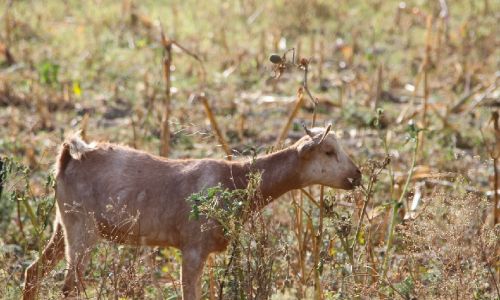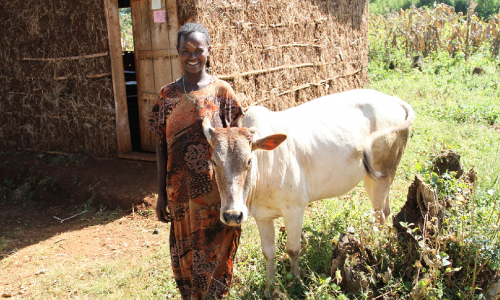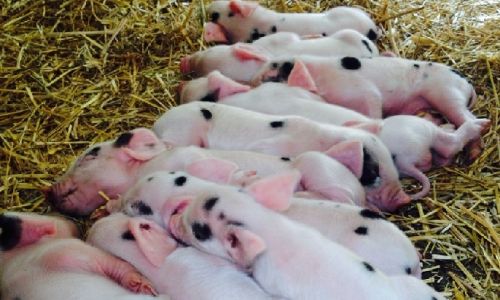The Case for Veterinary Leadership in Food Sustainability
We are in the midst of the ‘livestock revolution’ – an era of unprecedented growth in global farm animal populations, presenting profound environmental and ethical challenges to society.
Laura Higham for Veterinary Practice Magazine
We are in the midst of the ‘livestock revolution’ – an era of unprecedented growth in global farm animal populations, presenting profound environmental and ethical challenges to society. At a time of significant political flux and media attention that often demonises animal agriculture, now is the time for the veterinary profession to shed light on our vast and diverse contribution and opportunities in sustainability. The collection and reporting of economic, ethical and environmental (‘3E’) outcome measures as part of a sustainability scorecard presents a new opportunity for vets to become ‘sustainability practitioners’ and drive quantifiable improvements at farm level, to secure a food system fit for the future.
Animal production – yielding meat, milk, eggs, wool and hides – has been positively linked to human wellbeing and environmental health for centuries. In some regions, livestock grazing is amongst the few land use and livelihood options available, with 1.3 billion people depending on livestock for their livelihood, including one billion of the world’s poor (LID, 1999). Farming systems incorporating grasslands and silvopastures offer carbon sequestration, and nomadic pastoralism, holistic grazing strategies and mixed farming can deliver environmental benefits by promoting biodiversity and building soil fertility. Livestock are a unique asset to a farming family, representing a source of income, employment and nutrition, and providing draft power, fertiliser, fuel, clothing and building materials in some regions. Small amounts of animal protein can contribute substantially to the nutritional profile of our diets. These enduring links between people, animals and our shared environment are embodied in the concept of ‘One Health’.
But we are in an era of unprecedented growth in global farm animal populations – the ‘livestock revolution’, driven by our growing consumption of animal products. This trend is presenting profound environmental and ethical challenges, contributing to the anthropogenic pressures we are exerting on the earth’s ‘planetary boundaries’ (Rockström and others, 2009). Animal agriculture uses more land than any other human activity, and existing systems of production are linked to the displacement of natural biomes, indigenous communities, and land that has potential for producing human food crops. Agriculture has encroached upon natural habitats with repercussions on biodiversity – notably affecting the Amazon rainforest and Brazilian Cerrado in the pursuit of beef and soy production, but also the in the UK. Hayhow and others (2016) report a decline in 56% of British wildlife species since 1970, with agricultural intensification cited as the most significant driver of change.
Greenhouse gas emissions, pasture degradation, water use and water pollution through nutrient loading add to the significant environmental costs of some livestock production systems (Poore and Nemecek, 2018). Animal health and welfare, zoonotic disease and antimicrobial resistance linked to medicine use in livestock are significant concerns, particularly with economic pressures on supply chains to meet the increasing demand for cheap animal protein, through ‘sustainable intensification’. Furthermore, dietary inequality and over-consumption of saturated fats associated with animal products are contributing to a human obesity epidemic worldwide.
Our challenge as vets and informed citizens is to help to address this myriad of ethical and environmental challenges presented by livestock production, against a backdrop of economic pressures and volatility affecting farming livelihoods, whilst harnessing the multiple benefits of animal agriculture to human civilisation.
Definitions of sustainability
‘Sustainability’ fundamentally implies the long-term viability and stability of a system (Tlusty and Thorsen, 2016), and should incorporate the economic, environmental and ethical dimensions (‘3Es’) of food production previously discussed. Animal welfare is increasingly included in the ethics of sustainability, in recognition of its inextricable links to animal health, food safety and emerging consumer preferences (de Passillé and Rushen, 2005).
Vets as ‘sustainability practitioners’
As acknowledged in the Vet Futures report (2016), veterinary surgeons deliver wide range of sustainability services to society. Firstly, vets are uniquely positioned to reduce waste in global livestock supply chains. One fifth of all livestock are lost to disease (Vallat, 2015), a situation described as ‘one of the greatest untold stories of food waste today’, and one representing a significant animal welfare impact, environmental footprint and financial loss. Indeed, the frequently postulated need to ‘double’ food production by 2050 is contrary to evidence that we already produce enough to feed nine billion people, if we tackle avoidable food wastage from farm to fork. As animal welfare advocates, vets can also ensure robust advocacy for animal welfare in the sustainability discourse.
As another example, vets are custodians of several essential public goods for human health, including antimicrobial stewardship, food safety and food quality. As a profession, we are gatekeepers of prescription medicines and therefore play a central role in tackling antimicrobial resistance, an issue that is widely understood to be one of the greatest challenges facing humanity.
The personal and social support function of veterinary practitioners is a significant but under-recognised area of the sustainability services that we provide. Many authors have described members of our profession as ‘community care givers’, contributing to public and mental health, and supporting patients, clients and colleagues in our day-to-day work. Given the important interactions between farmer wellbeing and animal welfare, the benefits of our social role are far-reaching.
Measuring performance in sustainability
Box 1: Examples of 3E outcome measure categories. (Source: faifarms.com/our-approach/).
Despite the multitude of sustainability roles that are intrinsic in our day to day work, vets are not acknowledged as agents of sustainability by ourselves and by society. The many complexities and trade-offs between environmental, ethical and economic issues surrounding livestock production may in fact be sources of debate and contention between us, and therefore must be considered objectively to inform concerned action and decision making at local and global level. The answer may lie in scientific ‘outcome measures’ – quantitative indicators of the impacts of livestock production systems and standards, which can equip farmers, suppliers, retailers, vets and other stakeholders with a common set of measures to monitor and evaluate the sustainability of agriculture over time. See Box 1. 3E outcome measure scorecards should be developed, collected and shared with farmers and supply chain intermediaries to ensure relevance and practicality, and to secure support by all stakeholders. Regular collection and submission of the measures by farmers for collation, analysis and feedback can identify the farming practices with positive and negative impacts across the 3Es, driving continuous improvements. As vets and sustainability practitioners, we could coordinate the development and deployment of 3E scorecards in livestock supply chains.
Opportunities to apply an outcome measures approach
Retailers, food service companies, assurance schemes and the post-Brexit government are likely to request greater visibility of health, welfare, productivity and environmental data at farm level across all species. By taking ownership of outcome measure data collation in a 3E scorecard as part of our work, we can not only capitalise on an emerging commercial opportunity, but take a leading role in a data-focused approach that is urgently needed to drive progress. By analysing the measures, we can champion the systems of livestock production and management that optimise animal welfare, farm performance and environmental outcomes, and devise solutions to minimise the ethical, environmental and economic costs of production.
The provision of environmental advice to farmers alongside paraprofessionals presents an opportunity for diversifying veterinary surgeons and practices – here we can learn from aquaculture veterinary services, to which environmental consultancy is fundamental. Based on outcome measure data, farm-level consultancy by coordinated, multidisciplinary teams on sustainable feed and forage, soil health, manure management, water and waste recycling, wildlife conservation and the fulfilment of environmental aspects of assurance schemes and post-Brexit support payments could significantly reduce the environmental footprint of UK livestock production.
Vets have a professional mandate to take decisive action on antimicrobial usage and stewardship in agriculture. Although vets are contributing to industry positions, for example through RUMA, we could arguably take more action as individual professionals to monitor our antimicrobial usage as part of a sustainability scorecard, and unite behind an agenda on reducing, replacing and refining antimicrobial usage. This is an opportunity to underline our expertise in preventative health, and design and promote husbandry systems with animal wellbeing at their core.
Conclusion
Sustainability challenges present fascinating opportunities to employ the sort of interdisciplinary enquiry that is familiar to vets. With our ‘veterinary passports’, doors are opened to a multitude of roles, from practice to politics. As a profession largely trusted and respected by the public (Vet Futures, 2016), we have the platform from which to advocate the farming systems that optimise animal welfare, farm performance and environmental stewardship, to influence consumer choices – for example, through initiatives such as the BVA’s ‘Choose Assured’ campaign.
We also have the platform to advise at local, national and global level on some of the bold and disruptive systemic changes in animal production that would help us to balance the economic, ethical and environmental impacts of our food system. When we adopt a scorecard approach to monitor 3Es outcomes, I trust we will see vets driving new norms in livestock farming – in production systems, genetics and environmental practices - that will strengthen and future-proof our food system.
This article is published for the launch of Vet Sustain, the new online sustainability platform for veterinary professionals. Find out more at www.vetsustain.org and email [email protected] to join our mailing list.
Acknowledgements
Thank you to ffinlo Costain, Danny Chambers, Ruth Clements, Sean Wensley, Simon Doherty, Alex Tomlinson, Ruth Layton, Ashleigh Bright, Oistein Thorsen and Chris Tufnell for kindly critiquing this article, and for their invaluable advice.
References
de Passillé, A.M. and Rushen, J. (2005) Food safety and environmental issues in animal welfare. Rev. sci. tech. Off. Int. Epiz. 24(2): 757-766.
Hayhow, D.B., Burns, F., Eaton, M.A. and others (2016) State of Nature 2016. The State of Nature partnership. Pp 6, 12.
Livestock In Development (LID) (1999) Livestock In Poverty- Focused Development. Crewkerne: Livestock In Development. Pp 11- 21.
Poore, J. and Nemecek, T. (2018) Reducing food’s environmental impacts through producers and consumers. Science 360: 987-992.
Rockström, J., Steffen, W., Noone, K. and others. (2009) Planetary Boundaries: Exploring the Safe Operating Space for Humanity. Ecology and Society, 14 (2): 1.
Tlusty, M.F. and Thorsen, O. (2016) Claiming seafood is ‘sustainable’ risks limiting improvements. Fish and Fisheries 18(2).
Vallat, B. (2015) Feeding the World Better By Controlling Animal Diseases. Editorial from Director General, World Organization for Animal Health Online, September 8, 2015.
Vet Futures (2016) Taking charge of our future: A vision for the veterinary profession for 2030. RCVS and BA, London. Pp 23-24, 50.
The case for veterinary leadership in food sustainability
Available via Vet Practice Magazine.



